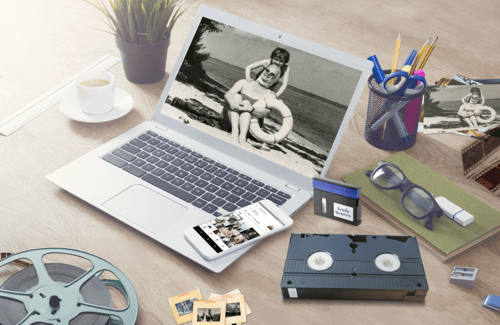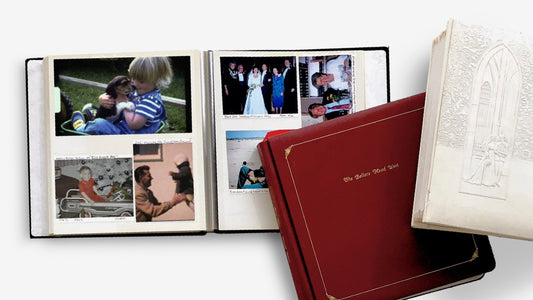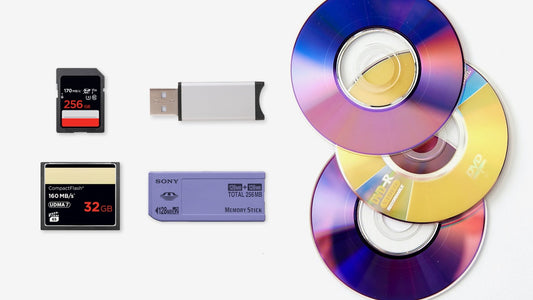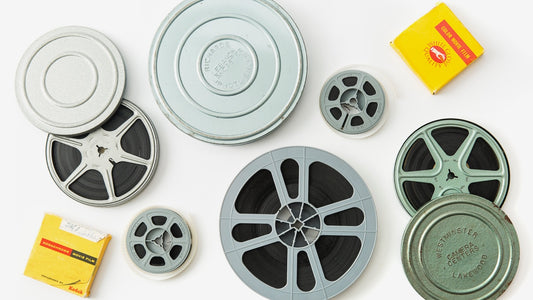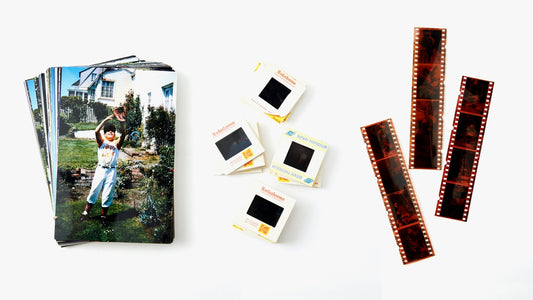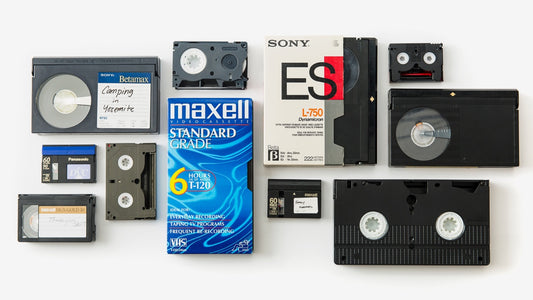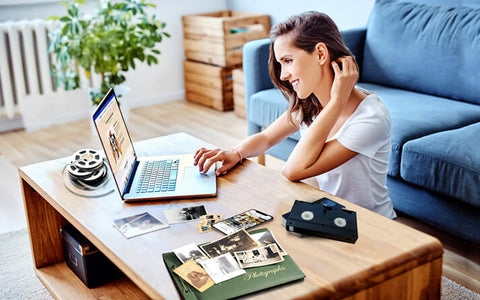Your collection of 35mm slides is a visual timeline of your family’s story, but sharing that story with younger generations can be a challenge. They’ve never gathered around a projector screen; they share memories through texts and social media feeds. Digitizing your slides bridges that generational gap, transforming moments from the past into a format that’s instantly shareable and relevant today. It’s about more than just preservation—it’s about connection. This guide will help you find the best way to digitize 35mm slides, so you can finally send that photo of grandpa’s first car to the family group chat and watch the stories unfold all over again.
Key Takeaways
- Decide Between Professional Quality and a DIY Project: A professional service offers the best quality and saves you significant time, making it ideal for large collections. The DIY route is a rewarding hands-on project if you have the right equipment and are prepared to invest the time.
- Clean and Organize Your Slides First: Before you begin, use compressed air to remove dust and group your slides by year or event. This simple prep work prevents flawed scans and makes it much easier to find your favorite digital photos later.
- Aim for Quality, Not Just a Digital Copy: For great results, scan at a resolution that creates about a 10-megapixel image and be prepared to color-correct faded photos. This final polish is what turns a basic scan into a beautifully preserved memory.
How Can You Digitize Your 35mm Slides?
If you have boxes of old 35mm slides tucked away, you’re sitting on a treasure chest of family history. Each tiny frame holds a moment—a birthday party from the 70s, a road trip from the 80s, or just a quiet afternoon in the backyard. For years, the only way to see them was to haul out a clunky projector and screen. But what if you could bring those memories into your daily life, ready to be shared with a simple click? That’s exactly what digitizing your slides does. It transforms them from forgotten relics into vibrant digital photos you can edit, print, and post online for family and friends to enjoy.
Choosing how to digitize your slides really comes down to what matters most to you. There are a few different paths you can take, and each one offers a unique balance of quality, cost, and convenience. You could hand them over to a professional service that has the high-end equipment and expertise to create stunning, high-resolution images. This is a fantastic choice if you have a large collection or if achieving the best possible quality is your top priority. On the other hand, if you enjoy a hands-on project and have some time to spare, the do-it-yourself (DIY) route using a dedicated scanner or a digital camera can be incredibly rewarding. And for a quick and easy solution, you can even use your smartphone to get a fast preview of your slides. We’ll walk through each of these options so you can find the perfect fit for your precious memories.
First, What Exactly Are 35mm Slides?
Before you start, it helps to know exactly what you’re working with. 35mm slides, which were especially popular from the 1960s onward, are small, individual photographs on a piece of positive film. Unlike a film negative where the colors are inverted, a slide shows the image in its true colors. Each tiny photo is mounted in a sturdy cardboard or plastic frame, designed to be dropped into a projector and beamed onto a screen for a family slideshow. Because they are positive images and meant for projection, they often contain incredible detail and vibrant color that can be lost in old photo prints. Understanding this helps explain why they require a specific digitizing process with a backlight to properly capture the image.
Using a Professional Scanning Service
If you want the best possible quality without the hassle, using a professional scanning service is your best bet. This is especially true if you have hundreds of slides or if you want to create large prints from the digital files. Professionals use high-end, specialized scanners and software to capture every detail and color with precision. It saves you an incredible amount of time and removes the technical guesswork. At YesVideo, our technicians handle every slide by hand, ensuring your memories receive the care they deserve. A photo transfer service is the most efficient way to get beautiful, high-resolution digital images that are ready to be shared and preserved for generations to come, letting you focus on the fun part: reliving the moments.
The Do-It-Yourself (DIY) Approach
For those who love a good project, the DIY approach can be a fulfilling way to reconnect with your family photos. This path gives you total control over the process, but it does require an investment in both time and equipment. You’ll need a special scanner designed for 35mm slides or a flatbed scanner with a transparency adapter. Another popular method among photography enthusiasts involves using a digital camera with a macro lens and a slide duplicator. While you can save on service fees, remember to factor in the cost of the gear and the hours you’ll spend scanning and editing each image. It’s a labor of love that can yield great results if you’re up for the challenge.
Scanning with Your Smartphone
If you’re looking for a quick, no-fuss way to see what’s on your slides, your smartphone can do the trick. Using a mobile app is by far the easiest and fastest method. Typically, these apps require you to hold the slide in front of a bright, white background—like a tablet or laptop screen—and then use your phone’s camera to snap a picture. While it’s a fantastic way to get a quick preview or share a low-resolution image on social media, the quality won’t compare to a dedicated scanner. This method is best for sorting through your collection to decide which slides are worth scanning at a higher quality, rather than for creating a permanent digital archive.
How to Choose the Best Method for You
Deciding between a professional service and a DIY project comes down to what you value most. There’s no single right answer, but by thinking through a few key questions, you can find the perfect path for bringing your slides into the digital age. It’s all about balancing the final quality you want with your budget, available time, and comfort level with technology. Let’s walk through each of these factors to help you make a choice you feel great about.
How Much Quality Do You Need?
Think about what you plan to do with your digitized slides. Are you hoping to create a large, high-definition print for your wall, or do you just want to share sweet family moments on social media? For the absolute best quality, a professional service is usually the way to go. They use high-end equipment that captures incredible detail and color accuracy, giving you results that are tough to achieve at home. If you have precious, one-of-a-kind images, a professional photo transfer ensures they are preserved with the highest fidelity. A DIY approach can still yield good results, but the quality will depend heavily on the scanner or camera you use.
What's Your Budget?
At first glance, the DIY route might seem like the most budget-friendly option. However, the costs can add up. A good dedicated slide scanner can be expensive, and you might also need to purchase software for editing. If you have a large collection, a professional service with a clear per-slide price can be more straightforward. Many people find that paying a service is money well spent because it saves them from buying equipment they’ll only use once. It also frees up hours of their time. Before you decide, calculate the potential cost of DIY gear versus the quote from a professional service to see what makes the most financial sense for your project.
How Much Time Can You Spend?
Be honest with yourself about how much free time you have. Digitizing slides, especially if you have hundreds or thousands, is a significant time commitment. Scanning each slide individually, editing the images, and organizing the files can take months. If you’re looking for a project to chip away at over the winter, DIY could be a rewarding process. But if you want your memories digitized and ready to share within a few weeks, a professional service is your best bet. With a service like YesVideo, you simply pack up your slides and let the experts handle the entire time-consuming process for you.
Are You Comfortable with Tech?
The DIY approach requires a bit of technical know-how. You’ll need to set up your scanner or camera correctly, figure out the optimal software settings, and perform color correction and touch-ups on your own. If you enjoy tinkering with technology and learning new software, this could be a fun challenge. However, if you’d rather not deal with the hassle of troubleshooting equipment or editing software, a professional service is the clear winner. They take care of all the technical details, from scanning to color correction, delivering polished, ready-to-enjoy digital files without you having to lift a finger.
A Closer Look at Professional Scanning
Handing over a box of your family’s precious memories can feel like a big deal, but professional scanning services are built to handle these moments with care. When you work with a pro, you’re not just paying for a machine; you’re paying for expertise, high-end equipment, and a process designed to deliver the best possible results with minimal effort on your part. It’s the ideal choice if you want top-tier quality without the steep learning curve of doing it yourself.
Going with a professional service means you can skip the technical setup and troubleshooting. Instead, you can focus on the fun part: getting ready to see your old slides in a brand-new light. From color correction to dust removal, these services handle the tedious work, ensuring your final digital images are clear, vibrant, and ready to be shared. Let’s break down what you can expect when you let an expert handle your slide collection.
What to Expect for Quality and Resolution
When you choose a professional service, you’re tapping into commercial-grade scanners that produce far better results than most at-home devices. These machines capture incredible detail, which is essential for getting sharp, clear digital images. For 35mm slides, a good service will scan at a resolution that creates a high-quality digital file, often around 10 megapixels. This ensures your images are large enough for making beautiful prints up to 13 by 9 inches.
The real advantage is the combination of powerful equipment and trained technicians who know how to get the most out of every single slide. They handle the entire photo transfer process, ensuring each memory is preserved with the quality it deserves.
How Pricing Works
Most professional services charge on a per-slide basis, which makes it easy to estimate your total cost. Prices can vary, but you can generally expect to pay a set fee for each image you want to digitize. For example, some services might charge around 48 cents per slide. If you have a massive collection of a thousand or more slides, the cost can add up, but it’s an investment in preserving your family history for generations to come.
Before you commit, it’s a good idea to count your slides to get a clear picture of your budget. Many services, including YesVideo, provide a secure, pre-paid shipping box, so you know exactly what to expect from the start.
Looking for Extra Features?
One of the biggest perks of using a professional service is access to advanced restoration features. Many scanners used by professionals include technology that automatically removes dust and minor scratches from the surface of the slide. This is a game-changer, especially for older slides that have been sitting in storage for decades, as it saves you hours of manual editing.
Beyond cleanup, most services also include manual color and exposure correction. Technicians will review your images to ensure the colors look natural and the lighting is balanced, bringing faded or discolored slides back to life. These extra touches are often included in the standard photo transfer price and make a huge difference in the final quality.
How to Work with a Scanning Service
The process of working with a professional service is designed to be straightforward. Your main job is to get your slides organized before you send them off. While not always required, sorting them into batches or labeling them can help you keep the final digital files in order. Once you place your order, a good company will send you a kit with everything you need to safely pack and ship your memories.
From there, the service takes over. Reputable companies like YesVideo provide order tracking so you can follow your slides’ journey. After the scanning is complete, you’ll receive your digital photos in your preferred format—typically via a digital download, on a USB drive, or on a DVD—along with your original slides, safe and sound.
Going DIY: Your Equipment Checklist
If you’ve decided to tackle this project yourself, your first step is to gather your tools. Having the right equipment is the key to turning that box of slides into a beautiful digital archive you can easily share. Your choice of gear will depend on your budget, the quality you’re aiming for, and how much time you want to spend on the process. Let's walk through the most common hardware options and the software you’ll need to get the job done right.
Using a Dedicated Slide Scanner
For the best possible image quality, a dedicated slide scanner is your top choice. These machines are specifically designed for one task: scanning slides and film negatives at high resolutions. Many models come with trays that let you scan multiple slides at once, which can be a huge time-saver if you have a large collection. While they deliver professional-grade results, they also come with a higher price tag. High-end scanners can be a significant investment, but if pristine quality is your number one priority, this is the route to take for turning your slides into crisp, clear digital images.
Using a Flatbed Scanner
If you’re working with a tighter budget, a flatbed scanner is a more accessible option. You might even have one already as part of an all-in-one printer. While convenient, be prepared for a trade-off in quality, as they generally don’t capture the same level of detail as a dedicated scanner. You’ll also need to put in a bit more manual effort. Most likely, you'll scan several slides at once and then use photo editing software to crop them into individual files. It’s a perfectly workable solution if you’re willing to spend a little extra time on the editing process.
Using Your Digital Camera
If you’re a photo enthusiast, you can get excellent results using a digital camera you already own. This method involves setting up your slide in front of a light source (like a lightbox) and taking a picture of it with a macro lens or a special slide duplicator attachment. It can be one of the fastest ways to digitize your collection, and the quality can be outstanding, depending on your camera and lens. If you have a DSLR or mirrorless camera, it’s worth exploring this camera scanning technique as a fast and effective option.
The Right Software for the Job
No matter which hardware you choose, the scanning process is only half the story. The right software is crucial for bringing your old memories back to life. After digitizing, you’ll want to use an editing program to correct colors, fix fading, and remove red-eye. Some scanners also come with built-in features like Digital ICE technology, which automatically detects and removes dust and scratches from the surface of the film. A little time spent on digital touch-ups will make a world of difference in your final images and help you achieve that polished, professional look.
How to Prep Your Slides for Scanning
Before you jump into scanning, taking a little time to prepare your slides can make a world of difference in your final digital images. Think of it as setting the stage for a great performance. A clean, organized collection not only produces clearer scans but also saves you a ton of time and potential headaches later on. Whether you’re tackling this project yourself or sending your memories to a professional service, these prep steps ensure your slides are in the best possible shape.
Proper preparation involves four key steps: carefully cleaning the slides, organizing them in a way that makes sense to you, checking for any damage, and planning for their safe storage after the project is done. This upfront effort helps protect your fragile originals and makes the entire process of digitizing your photos smoother and more rewarding. By following this guide, you’ll be well on your way to creating beautiful digital keepsakes that your family can enjoy for years to come.
Clean and Handle Slides with Care
Your slides have likely been sitting in storage for years, collecting dust and fingerprints. Since scanners are incredibly detailed, any speck of dust or smudge will show up on your digital image. To get the cleanest scan possible, always handle your slides by their cardboard or plastic mounts, and it’s a great idea to wear lint-free or anti-static gloves.
For a quick clean, a gentle puff of compressed air can blow away loose dust and debris. If you notice smudges, you can use a soft, anti-static cloth designed for photographic materials. Just be very gentle and avoid using any household cleaners or rough fabrics, as these can permanently scratch the slide’s surface. A little care here goes a long way in creating a crisp, clear digital memory.
Organize Your Collection Before You Start
Before you scan a single slide, organizing your collection will make your life so much easier down the road. Imagine having a folder of hundreds of digital files with names like "scan_001, scan_002..."—finding a specific photo would be a nightmare! Instead, try grouping your slides into categories that mean something to you. You could sort them by year, by event like "Grand Canyon Trip 1992," or by the people in them.
This simple step helps you create a logical folder structure for your digital files later on. If you’re sending your slides to a service, this organization will help you review your digital order and know exactly what you have. It transforms a box of random slides into a cohesive story, making it easier to share your memories with family and friends once they’re digitized.
Check Your Slides for Damage
Over the years, slides can suffer from more than just dust. Before you begin, inspect each one for signs of damage like mold, mildew, or water spots. If you find slides that are stuck together from moisture, don't try to force them apart. Instead, you can gently rinse them in clean, room-temperature water to help separate them. Once they’re apart, lay them flat on a clean, lint-free paper towel to air dry completely before scanning.
For more serious issues like widespread mold, the cleaning process can be delicate and risky. If you come across slides that are badly damaged, it might be best to set them aside for professional attention. A trusted photo transfer service has the tools and expertise to handle fragile originals and can often restore images you thought were lost.
Store Your Originals Safely
Once your slides are digitized, don’t just toss the originals back into that old shoebox! Proper storage will ensure they remain preserved for decades to come. The best way to store slides is in archival-safe materials that protect them from dust, moisture, and fading. Look for acid-free plastic pages, often called slide pages, that have individual pockets for each slide.
These pages fit perfectly into a standard three-ring binder, creating an organized and easy-to-browse physical archive. You can even label the pages to match the digital folders you created, making it simple to find the original slide if you ever need it. Storing your slides this way keeps them safe and honors the precious memories they hold.
Create Your DIY Scanning Workflow
Once you have your equipment and your slides are prepped, it’s time to create a repeatable process. A consistent workflow is your best friend for a big project like this. It ensures every slide gets the same treatment, which saves you from re-scanning later and gives your final collection a cohesive look. Think of it as your personal assembly line for turning old memories into new digital treasures.
Set Up Your Scanner or Camera
First, get your station ready. If you’re using a flatbed or dedicated slide scanner, make sure it’s on a level, stable surface where it won’t get bumped. For those using a digital camera, a tripod is essential to prevent blurry photos. You can use a special attachment called a "slide duplicator" or a "macro lens" with your camera. These tools help you get a sharp, close-up shot of the slide. You’ll position the slide in front of a light source, and your camera will take a picture of it. The key is to keep your setup consistent for every single slide.
Get the Lighting Just Right
Slides need light behind them to reveal the image, so your lighting setup is critical. You don’t need a professional studio to get it right. A simple lightbox works great, but you can also get creative. For example, you can use a bright screen, like a tablet or laptop displaying a blank white document, as a light source behind the slide. Some people even use a clean, north-facing window on an overcast day for soft, diffused light. The goal is to have bright, even illumination across the entire slide without any distracting hotspots or shadows.
Choose the Best Scanner Settings
Before you hit "scan," dive into your software settings. The most important setting is resolution, measured in DPI (dots per inch). For good quality, aim for at least 2400 DPI; 4800+ DPI is even better if your scanner supports it. A higher DPI creates a larger, more detailed digital file, which gives you more flexibility for printing and editing later. Also, check your color depth settings—choose 48-bit color if it’s an option, as it captures more color information. For file type, scanning to a lossless format like TIFF is best for archiving, while JPEG is great for easy sharing.
Calibrate Your Software
A raw scan is just the starting point. Most images will need a little love to look their best. You can use scanning software or photo editing programs like Photoshop to fix colors, fading, and red-eye. Many scanners come with software that includes basic tools for cropping and color correction. If you notice your slides have a consistent color cast (like a blue or red tint), you can often create a preset to correct it across the whole batch. If tweaking colors and removing dust specks sounds tedious, a professional photo transfer service can handle all the detailed restoration work for you.
How to Get High-Quality Digital Images
Once your slides are prepped and your equipment is ready, the real magic begins. The goal isn't just to create a digital copy; it's to create a beautiful, lasting image that does justice to the original memory. Getting a high-quality result from a DIY scan involves more than just pressing a button. It requires a careful eye during and after the scanning process.
Think of it like restoring a piece of furniture. You’ve cleaned it and now it’s time for the fine-tuning—the sanding, staining, and polishing that brings out its true character. For your slides, this means choosing the right resolution, correcting decades of color fading, and making small touch-ups to fix imperfections. These steps are what separate a quick, functional scan from a truly preserved photograph you’ll be proud to share. If this process sounds a bit intensive, remember that a professional photo transfer service handles all of this for you, ensuring every image is individually corrected for the best possible quality.
Pick the Right Resolution
Choosing the right resolution is a balancing act. You want enough detail to make beautiful prints, but going too high can actually work against you. For 35mm slides, a scan of around 10 megapixels (MP) is often the sweet spot. This resolution gives you a high-quality file that’s perfect for viewing on screens and can produce a nice print of up to about 13 by 9 inches. While it might be tempting to choose the highest setting your scanner offers, this can sometimes capture the film's natural graininess rather than useful detail, resulting in a slightly fuzzy image. Stick to a resolution that captures the essence of the photo without overdoing it.
Correct and Balance Colors
Over time, the dyes in photographic slides can fade, leaving you with images that have a pink or magenta tint. One of the most satisfying parts of digitizing is bringing that color back to life. Most scanning software includes built-in color correction tools that can work wonders on faded slides. Look for settings that let you adjust brightness, contrast, and color balance. Your goal is to restore the natural tones of the scene—making skies blue again and skin tones look realistic. A little adjustment can transform a washed-out image into a vibrant memory that looks as good as the day it was captured.
Make Minor Touch-Ups and Enhancements
Even with careful cleaning, some slides will have tiny specks of dust, scratches, or blemishes that show up in the scan. This is where photo editing software comes in. You don’t need to be a graphic designer to make simple fixes. Programs like Adobe Photoshop are powerful, but many free tools offer features like a "clone stamp" or "healing brush" to digitally erase dust and minor scratches. You can also use this software to crop your images for better composition or fix issues like red-eye. These small enhancements are the final polish that makes your digital photos look clean and professional.
Do a Final Quality Check
Before you call the project finished, give every image a final review. Zoom in on the details to make sure you’re happy with the sharpness and that you haven’t missed any distracting dust spots. Once you’re satisfied, it’s time to save your work securely. Don't just leave the files on your computer's desktop. As a rule, you should always save your digital photos in more than one location. A good system is to use both a physical external hard drive and a cloud storage service like Google Drive or Dropbox. This creates a vital backup, ensuring your newly digitized memories are safe from computer crashes or accidents.
How to Preserve Your New Digital Photos
Once you’ve digitized your slides, the next step is to make sure those new digital files are safe, sound, and ready for the future. Proper preservation is key to ensuring your hard work pays off and that these memories last for generations to come. Here’s how to handle your newly digitized photos.
Choose the Best File Format
When you save your scanned slides, you'll need to pick a file format. Think of it this way: TIFF files are your digital master copies. They are uncompressed and hold the maximum amount of image data, making them perfect for archiving and future editing. For everyday use, you’ll want JPEGs. These files are smaller and compressed, which makes them ideal for sharing via email, text, or social media. My advice? Save a high-quality TIFF of each image for safekeeping, and then create a separate JPEG version for all your sharing needs. This gives you the best of both worlds—pristine quality for preservation and lightweight convenience for sending to loved ones.
Decide on Digital Storage
Your computer’s hard drive shouldn't be the only home for your precious new photos. To truly keep them safe, you should always save your digital photos in more than one place. An external hard drive is a great physical option that you can keep at home, while cloud storage services like Google Photos or Dropbox give you access from anywhere with an internet connection. When you use a service like YesVideo, you can get your memories delivered on a thumb drive or through a secure digital media transfer directly to the cloud. The most important thing is to have multiple storage solutions so a single computer crash or lost device doesn't erase your family history.
Create a Reliable Backup System
A solid backup system is your best defense against accidentally losing your photos. Think of it as an insurance policy for your memories. A simple rule to follow is the 3-2-1 method: keep at least three copies of your photos on two different types of media, with one of those copies stored off-site. For example, you could have one copy on your computer's internal drive, a second on an external hard drive, and a third in the cloud. The initial photo transfer is the first major step in saving your history, and creating a reliable backup system ensures that your effort protects your family’s legacy for many years to come.
Get Ready to Share Your Memories
Now for the best part: enjoying your memories! The real magic of digital photos is how easy they are to share with the people who matter most. You can instantly send forgotten moments to family members across the globe, create a fun throwback post for social media, or build a beautiful digital slideshow for the next family reunion. You can even get creative and print your favorites to design new photo books or custom gifts. Sharing these memories brings them back to life and helps you reconnect with loved ones over shared history. If this project has you inspired, you can keep the momentum going with album scanning to bring even more of your family’s story into the digital age.
Troubleshooting Common Digitizing Problems
Even with the best intentions, the DIY slide scanning process can hit a few snags. From blurry images to uncooperative scanners, these little hurdles are common. But don't worry, most problems have a straightforward fix. Let's walk through some of the most frequent issues and how you can solve them, so you can get back to preserving those precious memories.
Fixing Poor Image Quality
Getting a crisp, clear digital image is the whole point, so it’s frustrating when your scans look fuzzy or off-color. For resolution, more isn't always better. Scanning a 35mm slide at around 10 megapixels is usually perfect for getting beautiful prints up to about 13x9 inches. Going much higher can sometimes just capture the film's natural grain, not more detail. Many scanning programs and photo editors also have tools to correct faded colors and fix red-eye. Some scanners even have a feature called Digital ICE that automatically helps remove dust and scratches, which can be a huge time-saver.
Solving Equipment Glitches
Sometimes the hardware itself is the source of the headache. If you’re using a semi-automated scanner, you might find it’s slower than you expected or occasionally jams, especially older carousel-style models. The best first step is always prevention. Before you even start, make sure your scanner's glass is perfectly clean to avoid smudges. When you handle your slides, always wear anti-static gloves to prevent fingerprints and static cling. For any dust or debris on the slides themselves, a gentle puff of compressed air or a quick wipe with an anti-static cloth can work wonders. These simple habits can prevent a lot of frustration down the line.
Working Through Software Issues
Once your slides are scanned, you’ll likely need to do a little digital tidying up. Most raw scans need some post-production work, like cropping the image to the right dimensions or making final color adjustments. This is a normal part of the process. To make this step easier, try to get your initial scan as clean as possible. Taking the time to clean your slides and the scanner glass beforehand means you’ll spend less time digitally removing dust specks later. Getting familiar with your scanning software's settings before you begin a big batch can also help you produce better initial images, saving you editing time on the back end.
Know When to Call a Professional
If you find yourself spending more time troubleshooting than scanning, or if you’re just not happy with the quality you’re getting, it might be time to call in the experts. There’s no shame in handing the project over to a professional service! After all, your time is valuable, and your memories are priceless. A dedicated service has the specialized, high-end equipment and trained technicians to get the absolute best quality from your slides. If you want to ensure your memories are preserved beautifully without the hassle, consider a professional photo transfer service. It’s a fast, efficient way to get high-quality digital images ready for sharing.
Related Articles
- How to Transfer Slides to Digital: DIY & Pro Guide
- Slide Digitization: Your Ultimate Guide for 2024
- Convert Slides to Digital Pictures: DIY & Pro Guide
- How to Convert Slides to Digital Pictures (2024 Guide)
Frequently Asked Questions
What's the difference between a 35mm slide and a regular film negative? Think of a 35mm slide as a miniature, ready-to-view photograph. It’s a “positive” image, which means the colors you see on the tiny piece of film are the true colors of the scene. This is why they look so vibrant when held up to the light. Film negatives, on the other hand, have their colors inverted and need to be processed and printed to reveal the final picture. Slides were designed for projection, so they often hold incredible color and detail.
I have my slides in old carousels and trays. Do I need to take them all out before scanning? Yes, you will need to remove the slides from their carousels or trays. Whether you are scanning them yourself or sending them to a professional service, each slide is handled individually during the digitizing process. Taking them out beforehand is also the perfect opportunity to give them a gentle cleaning and organize them by event or year, which will make managing your new digital files much easier.
How long does it really take to scan slides myself? Digitizing slides yourself is a project that requires patience. While the scanning time per slide might only be a minute or two, you also have to factor in the time for cleaning each one, setting up the equipment, and then editing and organizing the digital files afterward. For a collection of a few hundred slides, it’s realistic to expect this to take several afternoons or weekends to complete properly.
Is a professional service worth it if I only have a small collection of slides? It certainly can be. Even for a small batch, a professional service guarantees you’ll get the highest possible quality without having to buy specialized equipment you might only use once. If those few slides are especially precious—like photos of your parents' wedding—and you want them to look their absolute best for printing or archiving, letting an expert handle them is a wonderful investment in preserving those key moments.
My slides look really faded and have a pinkish tint. Can they be saved? Absolutely. That pink or magenta tint is very common in older slides as certain color dyes fade over time, and it’s one of the most satisfying issues to fix. Digital color correction can work wonders. Whether you use photo editing software on your own or send them to a professional service, those faded colors can be restored to their original vibrancy, bringing back natural-looking skin tones and blue skies.





